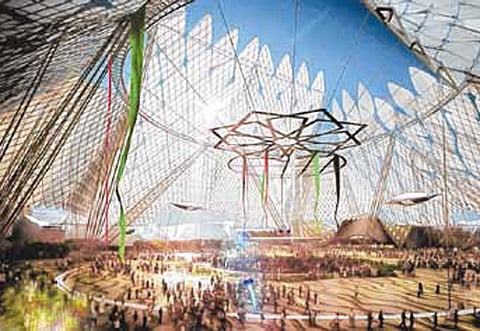World Expo 2020: New city to rise within Dubai
Site chosen is one of the largest ever earmarked for an Expo world fair

Dubai: World Expo 2020, the international event Dubai is bidding hard to bring home, would feature a spectacular exhibition, pavilions, cultures and business gatherings. What Dubai is hoping to do with it is make it a benchmark for human progress and a roadmap for the way forward.
Located on 438 hectares, the iconic design of Dubai Expo 2020 will be an additional permanent legacy to leverage the surrounding facilities and fostering innovation, education and global collaboration.
The site’s masterplan has been designed to visualise the country’s Expo bid theme: Connecting Minds, Creating the Future. On the southwestern edge of the city, equidistant between Dubai and Abu Dhabi and connected to 300 global destination every day, the site chosen is one of the largest ever earmarked for an Expo world fair. It will be 10 minutes from Jebel Ali Port and situated next to the new Dubai World Central Airport.
Developing blueprint
HOK, the leading group of expert firms, developed the blueprint for the specialised, highly connected environment. Experiential masterplanning specialist Thinkwell is designing Expo entertainment, including shows and performances. At the core of the site is an open plaza called Al Wasl (“the connection”) — a historical name for Dubai and branching out from the plaza are three main zones that symbolise the bid’s sub themes of opportunity, mobility and sustainability.
Each of these zones is arranged with a larger pavilion on the parameter and a small cluster at the centre to encourage the pedestrian flow across the entire site. This ensures all pavilions get dynamic presence in the heart of the Expo.
At the edge of this plaza in the convention pavilion, an entirely new pavilion concept that was designed to intensify all levels of Expo engagement with presentation, discussion and evolving exhibitions which will be created jointly by participants, visitors and guest thought leaders.
It would be a hub to connect so many people in so many ways every day, not just in terms of straightforward communication, but also culturally and socially.
Arab souq
Inspired by traditional Arab souqs, the design integrates the UAE’s unique architectural heritage and environment of vibrancy, interactive and trade with the requirements of the Expo to foster the fundamental principles of innovation, partnership and collaboration between participants and visitors.
From the exciting energy of the souq to the area for the best practices and innovation, opportunities bounce to form partnership for all nations as well as for private and public sectors inside.
Mobility, is the second way that weaves into the fabric of the design of Dubai Expo 2020, where state of art, computer central and logistic system are provided.
A fully automated underground system will connect all pavilions and support other facilities and enable invisible services along the opening hours.
Moreover, Dubai said it plans build an underground railway system to connect the Al Wasl with the outer pavilions. Dubai is competing against four other candidate cities, Sao Paulo (Brazil), Ayutthaya (Thailand), Azmir (Trukey), Ekaterinburg (Russia), bidding to host the 2020 edition of the monumental global gathering.
The winner will be announced in November following a vote by the 163 member nations of the Bureau International des Expositions (BIE), the Paris-based inter-governmental organisation responsible for the World Expo.
Transport
By 2020, the emirate will be able to offer enough transport links to accommodate about 25 million visitors to Dubai for Expo 2020. The mass-transit options will include zero-emission buses, new Metro stations and dedicated lanes on key arterial roads to take visitors to the planned site at Dubai Trade Centre – Jebel Ali.
As 80 per cent of the visitors are expected to use the mass transit, the Metro will be able up to ferry more than 75,000 people a day to the site, while commuters can board one of 750 ExpoRider buses from 35 points across the city.
The masterplan for 2020 includes construction of an extension to the Red Line that will take passengers from Jebel Ali to the Expo. In addition to all these, Expo lanes will be provided on the key arterial routes leading the site for the use of official vehicles, ExpoRider busess and taxis.
Future investment
Whatever infrastructure will be built it is an investment for the future. The site will serve as a permanent attraction beyond 2020 and will enhance further the UAE’s long-term appeal as a premier destination for high-profile global events
After the six-month event, the facility of 423 hectares would be further developed as a state-of-the-art exhibition and convention centre. The first phase of which would be the indoor entertainment venue to be built for Expo 2020.
There will be an institute Zone that encompasses research centres and university focused on fostering collaborative thought leadership between academia, corporations and entrepreneurs. The university would form the core of a new “institute zone” and would include research centres.
Legacy’ is one of the key words to be reflected through the Expo 2020 theme and post the mega event, the zone of the site will be transferred into a National Museum commemorating the evolution of the UAE and celebrating the first World Expo for the Arab World.
Sign up for the Daily Briefing
Get the latest news and updates straight to your inbox



